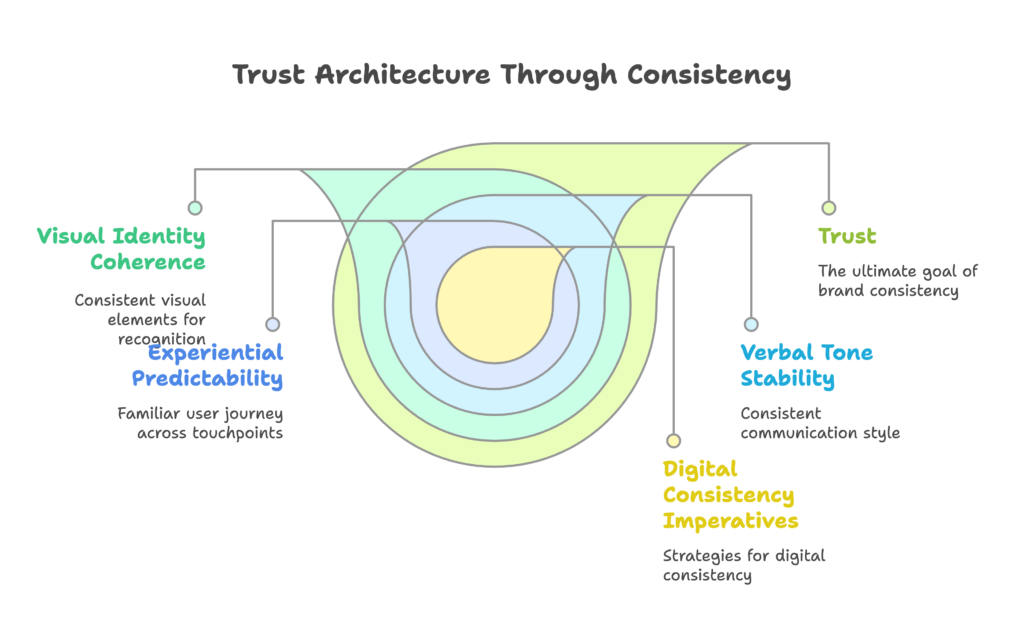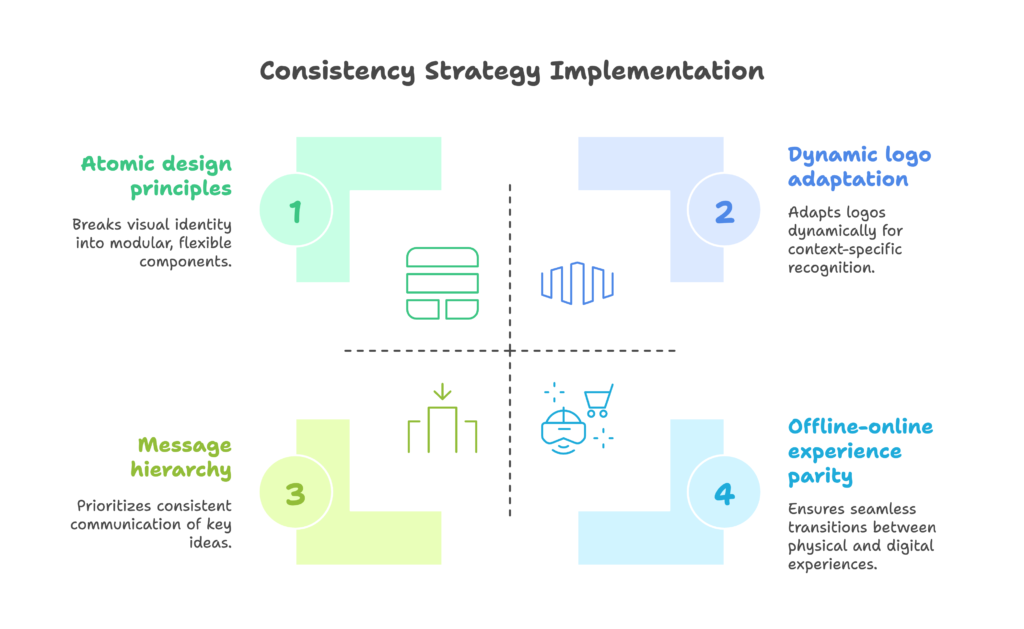Have you ever wondered why you instinctively reach for the same brand of coffee at the grocery store? Or why you feel immediately comfortable when visiting a website you’ve used before? That familiar feeling isn’t just coincidence—it’s your brain’s way of saying “I know this, and therefore I trust it.”
In today’s overwhelming world of endless choices, familiarity serves as our mental shortcut to trust. Think about it: when was the last time you felt completely at ease trying something entirely new? That slight hesitation you feel is familiarity bias at work.
By reading this article, you’ll discover:
- Why our brains are hardwired to trust what’s familiar
- How brands can build deeper trust through strategic consistency
- Practical ways to measure and optimize your consistency efforts
- Real-world examples of companies that transformed their results through familiarity engineering
Ready to unlock the science behind why consistency matters so much in building trust? Let’s dive in!
Neuropsychological Foundations of Familiarity Bias
Ever notice how meeting an old friend feels effortless, while meeting someone new requires more mental energy? That same principle applies to how we interact with brands and experiences. Let’s explore what’s actually happening in our brains when familiarity bias kicks in.
Cognitive Mechanisms
When we encounter something familiar, our brains process it more easily. Scientists call this “cognitive fluency.” Put simply, recognizing a familiar brand logo requires less brain power than processing a new one. Brain scans show reduced activation in the prefrontal cortex—the brain’s hard-working decision center—when we see familiar logos or interfaces.
Meanwhile, the amygdala (our emotional response center) reacts differently to familiar stimuli, typically with a more positive response. Our hippocampus, responsible for memory, engages in what scientists call “pattern completion”—filling in the blanks from previous experiences to help us quickly recognize and process familiar elements.
Evolutionary Origins
This preference for the familiar isn’t a modern marketing trick—it’s deeply rooted in our survival instincts. For our ancestors, familiar foods, places, and people meant safety. Unfamiliar elements required caution and extra attention to ensure they weren’t dangerous.
Today, we live in a world with countless choices—from dozens of coffee brands to thousands of websites. This creates a mismatch between our ancient brains and modern reality. Familiarity bias helps us navigate this overwhelming choice landscape by creating mental shortcuts.
Interestingly, this bias appears across cultures, though it manifests in different ways. Global brands must understand how familiarity operates differently across cultural contexts while maintaining core recognition elements.
Behavioral Economics Framework
From a decision-making perspective, familiarity influences how we perceive risk. The more we’re exposed to something, the less risky it feels. This is why new products often fail despite being objectively better—they carry an “unfamiliarity tax” in our minds.
Familiarity also reduces our cognitive load (mental effort), making decisions feel easier and more comfortable. When faced with too many choices, we often default to what we know—solving what psychologists call the “paradox of choice” through familiarity shortcuts.
Now that we understand why our brains are wired to trust the familiar, let’s explore how consistent experiences build that crucial foundation of trust. After all, you can’t have familiarity without consistency!
Trust Architecture Through Consistency
Think about your favorite app or website. What happens when they completely change their design overnight? That momentary confusion you feel is your trust being tested. Understanding how consistency builds trust isn’t just theoretical—it’s backed by fascinating brain science.

Neural Trust Signatures
When we interact with familiar brands, our brains release oxytocin—often called the “trust hormone.” This chemical response creates positive feelings and reinforces our connection with the brand. But this delicate chemical balance can be disrupted when a brand behaves inconsistently.
The anterior cingulate cortex, which helps detect errors and inconsistencies, becomes active when brand expectations are violated. Meanwhile, the insular cortex (involved in emotional processing) responds negatively to inconsistent messaging, creating feelings of unease or distrust.
Brand Consistency Components
Building trust through consistency requires attention to three key areas:
- Visual identity coherence: Consistent use of colors, typography, imagery, and logo presentation creates immediate recognition. Think about how quickly you recognize a Coca-Cola ad from just a glimpse of that red background.
- Verbal tone stability: Whether playful like Wendy’s or professional like IBM, maintaining a consistent voice across all communication channels reinforces brand personality and expectations.
- Experiential predictability: From website navigation to product packaging, the user journey should feel familiar and predictable at each touchpoint.
Digital Consistency Imperatives
In today’s digital landscape, consistency faces new challenges. Effective consistency requires:
- Cross-platform design systems that maintain recognition across websites, apps, and other digital touchpoints
- Content cadence optimization that delivers information with predictable timing and format to aid memory formation
- Micro-interaction reliability that ensures small interactions (like button behaviors or loading sequences) remain consistent
With a clear understanding of why consistency builds trust on a neurological level, let’s explore how to implement it strategically across your brand experience. After all, knowing why consistency matters is only useful when you know exactly how to apply it!
Strategic Consistency Implementation
Knowing that consistency matters is one thing—but creating a truly consistent experience requires thoughtful planning and execution.

Let’s break down the practical steps to build a consistency strategy that feels natural, not forced.
Identity System Design
Creating a consistent identity starts with designing flexible systems, not rigid rules:
- Atomic design principles break your visual identity into modular components that can be reassembled while maintaining recognition
- Dynamic logo adaptation frameworks allow your logo to adjust to different contexts while remaining recognizable
- Multisensory brand signatures extend consistency beyond visuals to include sound, motion, and even tactile elements
Content Ecosystem Strategy
Consistency in messaging requires more than just using the same words—it’s about creating an interconnected content system:
- Develop a clear message hierarchy that prioritizes which ideas should be communicated most consistently
- Create cross-channel narrative threading where stories and messages connect across different platforms
- Establish platform-specific adaptation protocols that maintain core messaging while respecting each channel’s unique requirements
Experience Reliability Engineering
The functional aspects of consistency are often overlooked but critically important:
- Design for error prevention with predictive UI patterns that anticipate user needs
- Ensure load state consistency so waiting experiences feel familiar across your digital properties
- Develop offline-online experience parity so transitions between physical and digital touchpoints feel seamless
With these implementation strategies in place, you’re well on your way to building a consistency engine. But what happens when that consistency creates a positive feedback loop with trust? The results can be transformative for your brand relationship—let’s explore how that cycle works!
Familiarity-Trust Feedback Loop
When consistency creates familiarity, and familiarity builds trust, something magical happens—a powerful cycle that accelerates brand relationships. This isn’t just theory; it’s a practical growth engine you can activate.
Trust Acceleration Mechanisms
Once basic consistency is established, you can strategically enhance trust through:
- Cognitive dissonance reduction by ensuring all brand elements align with customer expectations
- Social proof integration that confirms others have similar positive experiences at strategic moments
- Predictive personalization that adapts within consistent frameworks to make experiences feel both familiar and tailored
Crisis Consistency Management
The true test of consistency comes during challenging times. Prepare with:
- A brand voice preservation strategy for responding to controversy while maintaining your authentic tone
- Visual emergency response toolkits that adapt your visual identity appropriately for serious situations
- Recovery narrative sequencing that guides communications through crisis phases while maintaining core brand values
Cultural Adaptation Frameworks
Global brands face the challenge of being consistent while respecting cultural differences:
- Develop global-local consistency indices that determine which elements remain constant and which adapt
- Create archetype-based market adaptation models that maintain brand essence while adjusting to cultural expectations
- Implement cross-cultural familiarity calibration tools to test how different markets perceive your consistency efforts
Now that we understand how consistency creates a virtuous cycle with trust, you might be wondering: “How do I know if all this effort is actually working?” Excellent question! Let’s explore how to measure and optimize your consistency strategy for maximum impact.
Measurement and Optimization
Like any business strategy, consistency efforts need to be measured and refined. The good news? There are increasingly sophisticated ways to track how consistency impacts trust and behavior.
Neurometric Tracking
Advanced brands are now measuring consistency’s impact using brain-based metrics:
- EEG coherence scores that measure how quickly and easily the brain recognizes brand elements
- Eye-tracking consistency heatmaps that reveal where visual attention flows and whether it follows expected patterns
- Facial coding emotional congruence metrics that assess whether emotional responses align with brand intentions
Behavioral Analytics
More accessible measurement approaches focus on behavioral signals:
- Developing a Familiarity-Trust Index (FTI) that combines recognition, comfort, and confidence metrics
- Implementing cross-channel consistency scoring to identify where experiences feel disconnected
- Creating deviation impact modeling to understand which inconsistencies matter most to customers
Continuous Improvement Systems
Turn measurement into action with systematic approaches:
- Real-time brand monitoring dashboards that flag potential consistency issues as they emerge
- Automated consistency auditing tools that regularly check for alignment across touchpoints
- Predictive alignment machine learning models that suggest improvements before inconsistencies become problems
Measuring consistency might seem abstract, but its impact is anything but. Let’s explore some remarkable real-world examples of companies that transformed their results by engineering familiarity and consistency into their experiences.
Case Studies in Consistency Engineering
Theory becomes compelling when we see it in action. These real-world examples demonstrate the remarkable impact of strategic consistency on business results.
Financial Services Transformation
In an industry where trust is everything, consistency creates dramatic results:
- A major bank underwent visual identity unification across all touchpoints, resulting in a 38% increase in Net Promoter Score (NPS) as customers reported feeling more confident in their relationship
- Another financial institution ensured personality consistency in their chatbot interactions, reducing support contacts by 27% as customers developed trust in the automated system
Retail Experience Alignment
Retail brands have seen powerful benefits from consistency strategies:
- An omnichannel retailer created consistent inventory transparency across online and in-store experiences, boosting conversion rates as customers gained confidence in product availability
- A direct-to-consumer brand aligned its packaging and unboxing experience with its digital brand promise, generating significant increases in repeat purchases and referrals
SaaS Product Ecosystem
Software companies leverage consistency to improve adoption and retention:
- A productivity suite implemented consistent feature naming across its product ecosystem, reducing onboarding time by 42% as users could easily transfer knowledge between tools
- A subscription software provider established reliable update cadence and communication, resulting in a 29% decrease in churn as users felt more confident in the product’s future
These success stories are inspiring, but what’s even more exciting is what lies ahead. The future of familiarity engineering offers fascinating new possibilities and important considerations. Let’s peek around the corner to see what’s coming next!
Future of Familiarity Engineering
As technology and society evolve, how we build familiarity and trust will transform as well. Here’s where the leading edge of consistency strategy is heading.
Emerging Technologies
Tomorrow’s consistency tools will leverage advanced technologies:
- AI-powered brand consistency guardians that automatically monitor and maintain alignment across expanding digital ecosystems
- Neural interface familiarity calibration that could one day measure and optimize how new experiences connect to existing mental models
- Blockchain-based brand history ledgers that create immutable records of brand promises and interactions to build trust through verified consistency
Ethical Considerations
As familiarity engineering becomes more sophisticated, important questions arise:
- Solving the innovation-consistency paradox—how to introduce beneficial changes without breaking trust
- Preventing cultural homogenization as global consistency strategies must respect and preserve cultural diversity
- Developing familiarity addiction safeguards to ensure consistency strategies don’t exploit cognitive biases in harmful ways
Sustainability Integration
Long-term thinking is becoming central to consistency strategy:
- Long-term brand equity preservation approaches that balance short-term trends with enduring recognition
- Legacy communication system bridging to maintain consistency as platforms and channels continue to evolve
- Heritage-future alignment frameworks that honor brand history while preparing for emerging technologies and social changes
As we’ve seen throughout this exploration, familiarity bias isn’t just a quirk of human psychology—it’s a powerful force that smart brands can harness through strategic consistency. By understanding the neurological foundations, implementing thoughtful consistency systems, and measuring their impact, you can build deeper trust with your audience.
Quick Reminder: Looking to increase sales in your Shopify store? Growth Suite helps you build consistent, familiar experiences that customers trust. With tools to maintain brand consistency across your entire store, Growth Suite makes it easy to turn familiarity into increased conversion rates!
References
- Vimi. (2023). Familiarity Bias in B2B Marketing.
- Kuwatly, B. (2023). Familiarity Principle in Marketing. LinkedIn.
- Desiree Design Studio. (2023). Why We Prefer Brands We Recognise.
- Zhang, J. & Ghorbani, A.A. (n.d.). Familiarity and Trust: Measuring Familiarity with a Web Site. NTU.
- Endert, A. et al. (2017). Trust in Visual Analytics.
- Kane, A. (n.d.). SEO’s Role in Exploiting Familiarity Bias. Alkane Marketing.
- The Behavioral Scientist. (2023). Familiarity Bias.
- Dia Creative. (2025). Future-Proofing Through Familiarity.




